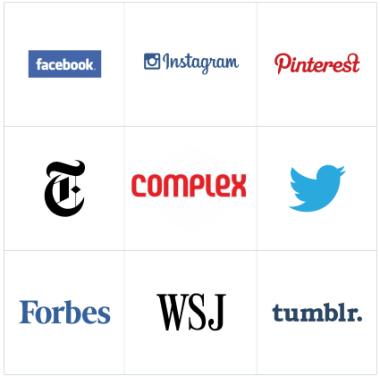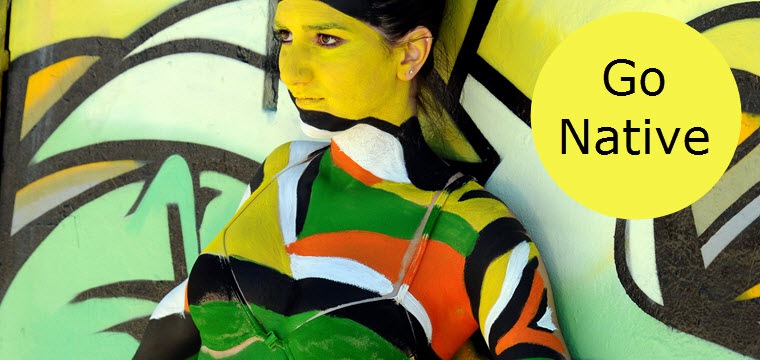 Example of Native Advertising – inserting relevant trending brand content within a high quality travel related post.
Example of Native Advertising – inserting relevant trending brand content within a high quality travel related post.Photo: courtesy of Socialmoms Screenshot taken 06/10/2014 of www.socialmoms.com .
Marketers are doubling down on content marketing and leveraging native advertising to achieve scale as visual content marketing tactics evolve and the arms race rages to reach consumer engagement.
In a recent post, I described steps brands are taking to get the most out of their content efforts via Content Marketing Fracking and Closing the Social Loop. Native advertising is being used to capture the consumer’s attention and reach the holy grail of viral sharing.
However, it is not without controversy and brands are in a FOMO (fear of missing out) moment because fickle customers will start engaging with your competitors and then you are on your way out.
Promoting content is key to achieving reach but just buying ads, posting on Facebook and Twitter, social media optimization, and SEO is not good enough.
The bar has been raised high and brands must step up quickly with smarter placement, packaging techniques, tools, and partnerships.
The market is pouring $44 billion into content marketing and native advertising is looking to push past the $5 billion mark by 2017 with no signs of stopping.
There is a sea of companies providing tools and services galore engineered to milk and create meaningful customer engagement. What you chose and how you use it will your determine success.
Going Native
 Publishers and sites that are top native advertisers. Photo: Created by Chase McMichael
Publishers and sites that are top native advertisers. Photo: Created by Chase McMichaelWhat’s native advertising?
Native advertising is a big buzzword in the marketing circle. It’s an attempt by advertisers to garner engagement through contextual experiences in an ad structure that acts less like an ad and more like editorial content.
The goal is to create a great user experience to induce sharing, clicks, and comments, which drives greater feed interaction and amplified reach.
Native advertising has been embraced by the majority of publishers and major social network even with the measurement issues. Most are offering some form of basic native advertising. If done well, it generates the discovery of entertaining, informative, educational, or down right funny content that may have not surfaced otherwise.
Problematic Content
With the tsunami of click fraud at an all time high, botnets are now acting like humans and programmatic buying is creating a race to the bottom.
Is there any hope for brand advertisers?
In the world of content marketing, robust engagement is alive and well. Brands are placing content as their top priority and using it as the key enabler for education, lead generation, and sales. John Battelle made a great point in a recent post and in some ways is a catalysts for native advertising:
“We buy audiences, but we aren’t buying the show they’re watching—we’re ignoring where that impression is served. This is nuts.”
Sadly, the native advertising we’re seeing is lots of smoke and mirrors and with magician tactics like “Top 100 Influencers”, “Top People”, “Top Sites” (social ego stroking) infographics, shocking images, over-manipulated viral videos, shocking headlines, and gamed wording, all in an attempt to make you think this is high quality, valuable content when it is just another attempt to drive you to look, engage, and share.
The FTC has cracked down on blogger product endorsements when they don’t disclose they are getting paid to distribute links, and Google has really gone after bloggers’ on the paid link side – so be careful on your content placement. Accepting payment for the rise of contextual content marketing in the form of native advertising will stay fairly lawless for now. BuzzFeed might not have invent native advertising, but they did sensationalized it.
The Native Matrix
 The Native Matrix was created by Felix Salmon.
The Native Matrix was created by Felix Salmon.Photo designed by Chase McMichael
A very cool matrix was created by Felix Salmon in an attempt to define the difference between PR, native advertising, brand journalism, content marketing, marketing, and blogging.
A major intersection between content marketing/native advertising is where editorial, PR, and content teams have to collaborate in a major way. Brands are creating “native” content (very similar to the content already on the pages where it’s placed), rather than having it be an obvious ad unit. Brands are surfacing and routing their best content intelligently, enabling visual HyperDiscovery similar to the way content recommendations do. HyperDiscovery bridges the disconnection between most digital silos creating the insertions within blog posts, publications, eCom, web, etc. providing timely and fresh content in a real-time format. Gone are the days of static images!
Consumers want many visual choices like Instagram, Pinterest, Tumblr, Facebook, LinkedIn, Twitter provide, and brands have to step up to those levels of content interaction. The more sophisticated a brand’s competition and customers become, the greater the amount of support required.
Agencies are very creative and have mastered the viral video like no other. Well paid and well placed content that’s highly scripted and heavily produced is entertaining. Its designed to maximize reach and increase shares with no regard to perpetual value.
Ongoing engagement and these highly radioactive content items have a very short half life. Brands have to think sustainability versus one off pops. Dove has done a great job of this with their real beauty campaign but who has that kind of budget? Most SMB’s struggle to get out posts and mid size brands staff only one or two people. So how can they make native advertising work for them?
5 Steps To Going Native and Takeaways
Before you bolt off and kick start a native advertising campaign via some promoted post method, Buzzfeed, or sponsored posts on some social platform, be sure you look closely at some of your top bloggers and publishers that are creating high quality branded articles you would be willing to read and share. These five steps apply to any content strategy, as well and outline what we have learned from effective native advertising techniques:
Content Marketing Rules
 Content Marketing Cycle: Are you promoting and recommending re-purpose content?
Content Marketing Cycle: Are you promoting and recommending re-purpose content? Photo: Wikimedia Commons
Consumers have higher engagement rates via brand content than from brand advertisements. This is a fact.
If you are using sponsored posts (Facebook – LinkedIn), promoted tweets (Twitter), and good old fashion organic social shares without killer content, those posts are going to be very costly because you won’t get the results you want.
In other words, you will be paying for every click and, as we all know, every click, retweet, and share doesn’t equal a conversion. The ROI here is based on cost per customer and ensuring that customer is being empowered to drive more sales via their network.
What’s more, native ads perform well based on recent studies, boasting a 19 percent higher left on purchase intent and 9 percent on brand affinity over banners ads. In fact, the right content is blowing the doors off traditional methods when promoted at the right time.
Its up to you to “go native” or stay in banner blindness. It is time to triple down on your content strategy.
Think Beyond the Ad Unit to Meaningful Content
Lets face it, even marketers want to read something engaging or that invokes a true emotion.
The best ads have their foundation anchored in content. Harness the storytelling side of being a great marketer and your brand will benefit. Regardless of being native or not, the goal of ads or content is to make you:
- Feel Something
- Invoke a Response
- Tap Into an Additive Behavior (not disruptive)
- Help Connect You with the Brand
Marketers are great storytellers, and the arrival of new platforms simply provides more tools for telling great stories. You are responsible for creating an experience that draws your customer through a process of education to purchase and ultimately an advocate.
Understand Your Placement Platform
 Boost your content all the time
Boost your content all the timePhoto: Wikimedia Commons
Knowing what works really well on what platform is the key to doing well in a native model.
YouTube has long been a great place for branded content. However, you’re competing with the pros. Movie marketers have long harnessed this platform. Successes such as Saw III and Devil Baby included the audience in the process of the content distribution. So if you’re going to…
- Sponsor posts on Buzzfeed, use the .gif list format that works
- Sponsored a tweet, include relevant hashtags and prompt your audience to retweet
- Follow people who engage, direct message possible advocates, and engage vloggers that appeal to your audience
Take a page from Brian Carter, who launched “These Are The 20 Most Viral Internet Posts On The Planet, And Yes They’re Shocking”. What’s most shocking is this post garnered 2-3 minutes average time on page. This example is inserting live content that behaves like a native ad, connecting with the content of the actual post.
There are many examples of content insertion but what’s unique here is the real-time aspect of the content updating and long engagement time.
Fish Where the Fish Are
 Fish where the fish are just be careful – you’re not swimming in your own pool.
Fish where the fish are just be careful – you’re not swimming in your own pool.Photo: Wikimedia Commons
Chris Brogan’s eBook outlined the “Fish Where The Fish Are” purchase process by posting content where your audience gathers. A rich nutrient environment attracts other fish, but a brand must be fluid with their content and clear on the call to action.
I’m not saying abandon your brand websites and eCom content pages. However, you must think of how to become more engaged and educated via social on those pages. Gone are the days where you can slap a social share button on some brochureware site and you’re good.
You should be thinking about:
- Creating dynamic and ongoing relevance to increase shares.
- Engaging your audience where they are, or your competitors will
- If you’re not bringing them back to a point of social engagement you’re missing an opportunity to re-engage.
- Identify the top engaging content and what your customers commenting on.
- If your customers are mobile, you better have killer mobile content capability or possibly a mobile app.
- The numbers are big for both mobile and global social network usage. Bring them together under one roof instead of spreading them over different divisions.
The party is way over on simply getting more fans. It’s all about content engagement and how to translate engagement into fans.
Are you maximizing the potential of your existing customers and expanding your fan base because of your great content? If your customer is in their social feed, you have to be there with your content. It’s that simple.
If they are on blogs or trade publications you have to join that party as well. It’s also about where we place our messages within the site itself. Facebook reports that 40 percent of its user’s time is spent within the news feed.
Custom is The New Black
Those in the business know one size doesn’t fit all and being unique is key to getting attention. Brands want to see unique placement and intelligence around their content versus just another ad. Brand marketers are looking for:
- Customer placement
- Unique packages
- Original thinking
- Innovation
- New way of delivery
- Low-cost
Native advertising helps put structure around the desire for custom content, helping advertisers get closer to the customer with targeted, relevant content. It also makes custom creative scalable, as most publishers have a dedicated native team assuring the message is right.
Trustworthy Content
 Be a Boy Scout when it comes to your content. Be “Trustworthy” and loyal to your customers.
Be a Boy Scout when it comes to your content. Be “Trustworthy” and loyal to your customers.Photo: Wikimedia Commons
We have all been duped into clicking on something from a site that has manipulated the feed headline or sensationalized an image. It’s a slippery slope with content marketing and native advertising where the pressure is on to get higher engagement.
Stop trying to trick your customers.
These tactics are not sustainable and over time will harm your brand. The “Bad press is good press if they spell our name right” mentality is nothing but desperation.
Some have attempted to mislead with “faux” content that appears unscripted just in an attempt to trick consumers into interacting. You have to be careful of how you are being perceived in the market.
About a year ago OPA released a study on native advertising best practices, marketer goals and metrics and IAB is working with brands and advertisers to create some standards. Regardless of where the industry is, creating sustainable content to consumer relationships is critical for brand to maximize native for the long-term.
Industry Influx
The democratization of the press and the leaked New York Times internal document about the decline in homepage traffic shows how social is eating their lunch. This is not new and goes to show there is more to come for all publishers and media houses.
With old media no longer controlling the printing presses and the democratization of content creation, it’s an open field for brands to capitalize on and diversify their publishing strategies. As for the publishers, the drive to increase revenue and expand the brand relationships will see more native advertising and content marketing amalgamation that pushes the boundaries of authenticity.
Where is this all going? Native advertising and content marketing connection is here to stay and no one is getting that cat back in the bag.
The success of BuzzFeed, Gawker , and Upworthy are applying relentless pressure on other content producers such as the New York Times, The Guardian, and The Atlantic.
We’re Just Getting Started
The burden is on the native advertiser to make amazing content beyond the flashy headline. Most often, link bait is being used and we see it rampant on Facebook with sponsored posts containing regurgitated YouTube videos or other “shocking” content in an attempt to suck people into a site shows us more paid or sponsored content.
The main issue with native advertising is the deception, making it hard for unwitting visitors to tell the difference between editorial versus ads. Native content is not new, but how you integrate and package it can differentiate your brands and create an evergreen content opportunity that keeps giving over time.
Your brand now has multiple personality disorder—and social is the more exciting personality—and your website is becoming boring. Why shouldn’t your website be as interesting as social? Having a boring website is like having your sysadmin do your sales.
Prepare for change and embrace new technologies that can improve your ability to generate a new data set used to higher engagement rates. Your social and content may be in the 21st century, but your website is stuck in the 20th century.
What are you doing to take advantage of native strategies and increase your reach?





![AI Overviews: We Reverse-Engineered Them So You Don't Have To [+ What You Need To Do Next]](https://www.searchenginejournal.com/wp-content/uploads/2025/04/sidebar1x-455.png)